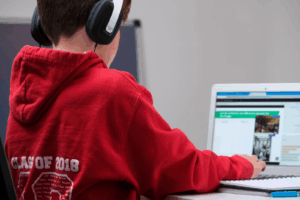 Have you been to a Whole Foods recently? Rather than paying with cash or card, consumers can now opt to pay by scanning their palm, which is linked to their Amazon account. Dystopian? Sure. Harmful? No comment. Is this not an excellent example of why digital literacy is maybe one of the most important skills a young person needs to learn today? Definitely.
Have you been to a Whole Foods recently? Rather than paying with cash or card, consumers can now opt to pay by scanning their palm, which is linked to their Amazon account. Dystopian? Sure. Harmful? No comment. Is this not an excellent example of why digital literacy is maybe one of the most important skills a young person needs to learn today? Definitely.
In the last few decades, concepts like computer literacy, media literacy, and information literacy have gained popularity. However, as the internet and digital media are becoming more complex, and information, media, and technological knowledge are becoming more interrelated, the necessity to have a foundational understanding of all these concepts is growing. That’s where digital literacy comes in: Digital literacy takes elements from each and combines them into a broad concept.
Digital literacy refers to the knowledge, skills, and attitudes that allow people to thrive in an increasingly digital world—it gives students the ability to effectively use digital tools and platforms to find, evaluate, create, and communicate information. According to the American Library Association (ALA), a digitally literate person is someone who possesses both the technical and cognitive skills to process information in various formats, utilizes different
technologies effectively and engages in digital spaces to collaborate with others and contribute positively to society. Digital literacy enables people to curate and consume information responsibly by teaching them to seek credible and reliable sources, create meaningful content, and foster online communities. A person with digital literacy can navigate the digital world with purpose and confidence. [1]
Students need digital literacy to thrive both inside and outside the classroom. Gaining these skills allows them to be both safe and empowered to utilize digital technology and media in a world that’s becoming more and more global. Digital literacy can help to improve learning, help students discern misinformation, and give students access to various resources. Likewise, it ensures users can protect their privacy, critically analyze digital data and information, ethically use digital platforms, and communicate with others eloquently. [2]
For students to gain these skills, they first require a comprehensive understanding of each of the five pillars of digital literacy. This foundation allows them to utilize digital tools and platforms effectively and strengthen their skills inside and outside of school. These five pillars are:
- Information and data literacy: The ability to discern and articulate information, the knowledge of how to locate that information, and the expertise to judge the source and content for its relevance and factuality.
- Communication and collaboration: The ability to interact, communicate, and collaborate effectively through digital technology, while being aware of cultural and generational diversity and the ways that people’s online collaboration can look different.
- Digital content creation: The ability to create and edit digital content, improving and integrating information and content into a body of knowledge while understanding copyright.
- Safety: The ability to protect oneself online, including devices, content, personal data, and privacy in digital environments. Likewise, the ability to protect and maintain one’s physical and psychological health through an awareness of the mental and environmental impact of digital technologies.
- Problem solving: The ability to identify needs and problems and resolve them in a digital environment. This can include using digital tools to innovate processes and products. [2]
Students with a strong foundation in these pillars, and therefore a high level of digital literacy, have improved writing, reading, listening, and speaking skills. They also have an increased ability to identify authentic materials, increased frequency and ability to use digital technology, enhanced ability to collaborate with educators and peers, enhanced engagement, and improved academic performance. However, simply being online isn’t enough to give students the skills they need to succeed. Development of digital literacy requires an active approach from educators and parents, who can:
-
- Emphasize the importance of critical thinking: Help students to learn to evaluate information resources to identify bias and perspective in resources.
- Provide guidance on how to avoid plagiarism: Once students can find trustworthy resources, they need to have the skills and knowledge to properly use and cite these resources. Teaching students about bibliographies, APA and MLA formats, and how to cite online information can help ensure that students avoid plagiarism.
- Teach students to manage their online identity: Help students understand that what they post on social media now will still be accessible when they’re adults.
- Help students manage digital distractions: With access to so much information and media, it’s easy for young people to get distracted by the online world. Teach students about boundaries by setting limits and the importance of not spending every waking moment online.
-
- Teach students about online safety: There are billions of people online, so ensuring a student safely uses digital technology is imperative. Parental controls are a good start, but students also need to know how to protect themselves.
Publishing Solutions Group
At Publishing Solutions Group, we believe that modern education must equip students not just to use technology, but to master it. The move toward a world of palm-scan payments and AI-driven content, as highlighted in this article, underscores an urgent need: digital literacy is no longer an elective skill but a core component of student success and safety.
This is precisely why, when working with our clients to support their digital content, we embrace the five pillars of digital literacy—from information evaluation and ethical creation to online safety—and work to incorporate them directly into curriculum and resources. We support students by creating the very materials that help educators foster the critical thinking, responsible communication, and proactive problem-solving skills that students need to navigate this complex digital world with confidence and purpose.
[1] https://potomac.edu/what-is-digital-literacy/
[2] https://pce.sandiego.edu/digital-literacy/
Photo by Compare Fibre for Unsplash.




